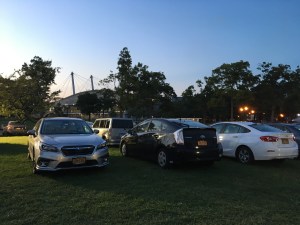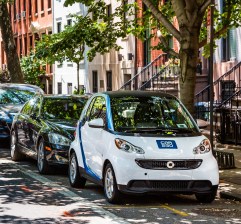Like death and taxes, New Yorkers complain about parking. And the media has long been their enablers.
These days, the local press likes to trot out random car drivers complaining that they can’t find parking because ___________ (insert any city program that has attempted to minutely tip the scales from drivers to everyone else such as open restaurants, open streets, wider sidewalks for pedestrians or a nascent effort to put garbage bags in the curbside lane and trim New York’s notorious 5 o’clock shadow).
“Sometimes I wait for hours to find a spot,” Luis Carrero of Kingsbridge Heights recently told the Daily News, claiming, “Years ago, it was easy.”
No, Luis, it wasn’t. Sure, there are tens of thousands more cars in the city now than before the pandemic, with car ownership increasing 12 percent, according to the NY Post, and, yes a few thousand spots were repurposed during the pandemic for the public instead of for private car storage, but Luis and his ilk are just flat-out wrong: It was never easy to park in New York City. Complaints from car owners are as long standing a tradition in New York as booing the mayor on opening day at Yankee Stadium.

How do we know? We asked the ultimate expert.
“Parking has been difficult for decades,” author Calvin Trillin told Streetsblog the other day. And he ought to know; in 2001, Trillin published the seminal, “Tepper Isn’t Going Out,” an entire novel about parking that was born from the author’s own years searching for a spot in Greenwich Village.
The problem he said is decades old and began “as soon as there were so many cars that if you put them in the end they would measure more than the parking spots.”
Trillin said that drivers should put today’s parking problems in context. Finding a spot will always be difficult “unless people just don’t have that many cars.”
Nonetheless, the car-owning minority of New York feels that free parking is it inalienable right. A safety improvement that might save the life of a kid or a neighbor are still met with outrage from drivers — and the media plays along, hyping how hard it is to park. But some reporters get it.
“New York has been synonymous with endless traffic jams, total gridlock, impossible parking and hours-long spot-hunting for decades. And it is nothing short of bizarre revisionism to even imply otherwise,” Aaron Gordon recently wrote in VICE.
Revisionism is the perfect word for today’s laments. We did a deep dive into the parking issue and here are some highlights:
Brooklyn Daily Eagle, Nov. 17, 1917

As early as 1917, car owners started asserting their entitlement to simply swipe the public curbside space. As detailed by the Brooklyn Eagle, the practice of storing a car in the public right of way was so bizarre that the police commissioner ordered a crackdown.
“Instructions were given that special attention should be paid to conditions in the vicinity of Borough Hall in Brooklyn,” the article said (wait, is this article from 2023?!).
The irony is that at the time, local merchants complained that car drivers who parked against the curb were deterring customers (the opposite complaint is made today).
At the time, street parking was a luxury allowed only to doctors who needed to rush to take care of a patient. So how come house calls disappeared, but theft of public space didn’t?
Brooklyn Daily Eagle, Dec. 22, 1921

As the popularity of the automobile continued to rise, parking became more of a crisis … for entitled drivers demanding space.
As this 1921 article shows, all kinds of solutions were pitched, including an intricate car parking system underneath parks, with 30,000 spaces created under Central Park and another 4,000 under Bryant Park.
“Parked cars today cause congestion, loss of life and injuries,” Deputy Police Commissioner Harriss was quoted as saying before describing his elaborate system that seems right out of an Elon Musk fever dream: “When a passenger would leave his car to enter a store or a theater for a considerable space of time, the car should be immediately sent to Central or Bryant park, subject to recall by an electronic flashlight system probably requiring six telephone operators in each parking tunnel.”
Harriss claimed, “Practically all of the large department stores have been studying the suggestion and are enthusiastic about it.”
Brooklyn Borough President Riegelmann was on board with efforts to ameliorate the parking “problem,” saying that “the parked car was rapidly becoming one of the biggest of the city’s transportation problems,” the Eagle reported.
This was back in the days when parking one’s car overnight on a street was simply prohibited.
“In those days, people thought that the streets should not be used to store automobiles,” the legendary parking expert Donald Shoup of UCLA, told Streetsblog the other day. The shift, he said, “was that drivers kept insisting, ‘Here’s all this wonderful space that you prohibit us from using.’”
The New York Times, Dec. 6, 1923

In the 1920s, truckers were the canaries in the coal mine of New York City parking, what with their work constantly impeded by cars. In 1923, the Merchant Truckmen’s Bureau of New York declared that the only way to really improve traffic issues was to ban car parking in busy areas of the city.
The police department provided limited off street parking, but people didn’t use them “because the car owners have to walk three or four blocks back from the place they parked the car, to their business.” Aww, baby.
The New York Times, April 22, 1945

As more and more soldiers returned home from World War II and vacant lots were converted to buildings, the city faced a flood of new traffic and fewer off-street parking spaces.
At the time, the auto lobby acknowledged that parked cars were the problem — but the car industry’s solution was hardly to deter driving and parking, but to encourage it!
George Conrad Diehl, of the Automobile Old Timers, demanded that the city cut “at least” four new crosstown boulevards for cars, with parking spaces installed underneath. He claimed “these broad arteries would more than pay for themselves … through the economic service they rendered.” He was wrong — roadways have been widened, but congestion still cripples the city and hampers economic development.
‘The Odd Couple,’ Oct. 19, 1973
As the decades went on, New York streets did magically add parking spaces, yet New Yorkers kept trying to squeeze more cars into them. In the 1970s, the prospect that a New Yorker would buy a car was still played for laughs — because, how ridiculous it would be for someone who lives in the heart of Manhattan to think owning a car would make his life easier!
Episode six of the fourth season of the iconic New York comedy, “The Odd Couple,” makes this abundantly clear.
After Oscar wins a car on a game show, he and Felix increasingly realize how difficult it is to find parking. First, they seek an off-street spot at a garage, but the garage manager (played perfectly by John Byner) claims he doesn’t have space for them (watch the seminal scene here). Failing to bribe a garage owner (“What will this get us,” Felix says, showing the $10 bill, to which the garage owner says, “Two fives?”), Felix and Oscar decide they’ll try to park on the street.
“Yeah, yeah, try it on the street for a while,” says the garage owner. “You’se’ll be back!”
Later, Oscar has had enough, and tries to hire a thief to steal the car.
“I’m sick of cars! I’m sick of parking! No argument, we’re getting rid of the car!” Oscar screams.
Felix persuades Oscar that his plan is morally bankrupt and that, “The Lord will never forgive you.”
“If he owned a car in New York he would,” Oscar retorts. (Watch the scene where they decide to get rid of the car here.)
In they end, “la Forza del destino” intervenes and they are forced to sell the car for $56:

Texas Monthly, February 1976

A 1976 article in Texas Monthly described the difference between Texans and New Yorkers’ relationship to their cars. Naturally, the topic turned to parking, which the magazine described as so difficult that it has “caused a lot of city divorces.”
‘Seinfeld,’ April 22, 1992

There are few pieces of pop culture that captured the experience of being a New Yorker like the show about nothing. In “The Parking Space” (S3 E22), an iconic “Seinfeld” episode, George is backing into a parking space when someone else tries to drive into the space front ways (which even we acknowledge is anti-social behavior). The resulting argument over who should get to park there lasts the entire episode, and both George and the other man are stubborn enough to wait until their rival leaves.
“People kill for a parking space in this city,” Elaine tells George when he decides he’s going to challenge the other driver.
(Watch the scene where the argument begins here.)
The New York Times, June 13, 1999

This 1999 Times article, headlined “The Space Race; Why Is It So Hard To Find a Parking Space In Manhattan?” shows how far the car invasion had come from 1917, when street parking was a crime.
New York car owners had accepted the right to street parking as a fundamental truth, and the focus of news articles shifted to the apparent injustice of not being able to find a parking space.
“New York is a crowded place, with two million vehicles registered in the five boroughs, and many millions more coming in daily from the suburbs and beyond,” the article states. “There just isn’t room for all of them on the streets. Demand for parking exceeds supply. Simple as that.”
At the time, car interests were pushing the city to require developers to build more off-street parking in their projects — the dreaded mandatory minimum parking rules that the city has been struggling to undo for decades. Not everyone was buying it, though.
Then-Soho Council Member Kathryn Freed said she didn’t like the idea of adding more parking, even off-street.
”I know people who live in the city need places to park,” she said. ”But we are so congested that the idea of allowing more parking in the center of the city is insane.” (Where have you gone, Kathryn Freed — a city turns its lonely eyes to you.)
The New Yorker, Aug. 23, 2012

Arriving closer to the present day, we see that very little has changed. This New Yorker article by Thomas Beller, aptly titled “Parking: The Agonies and the Ecstasies,” is a story of the pain of hunting for parking, and the pure “joy” of finding a great spot. You know the parking situation is dire when finding a spot causes the kind of emotional outpouring that used to be reserved for weddings, adventures or the smile of a dog.
Of course, not every car owner has a rosy-eyed view of the past.
“Parking here has always been a clusterf–k!” Astoria resident and bartender Joey Izzo told the Post last year. A few spots lost to outdoor dining “hasn’t changed” anything, he added.


